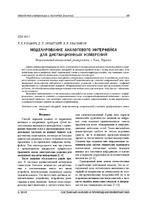Моделирование аналогового интерфейса для дистанционных измерений
Another Title
Simulation of the analogue interface for remote measurements
Bibliographic entry
Кузьмич, Л. В. Моделирование аналогового интерфейса для дистанционных измерений = Simulation of the analogue interface for remote measurements / Л. В. Кузьмич, Д. П. Орнатский, В. П. Квасников // Системный анализ и прикладная информатика. – 2019. – № 2. – С. 39-47.
Abstract
Данная работа ориентирована на поиск возможностей по повышению точности дистанционных измерений и помехозащищенность аналоговых интерфейсов централизованного типа с помощью резистивных тензодатчиков путем внедрения новой структурной схемы и способа коррекции ошибок, что позволяет уменьшить уровень ошибок по отношению к известным аналогов в десятки раз. Разработана схема аналогового интерфейса, содержащая измерительную цепь, тензодатчик, вход которого соединен с источником питания через аналоговый демультиплексор, а выходы измерительной цепи через аналоговый мультиплексор подключены к измерительному усилителю, и двухканальный аналого – цифровой преобразователь с одновременной выборкой. Измерительный цепь выполнена в виде трех резистивных делителей тока, где один делитель образован резистивным тензодатчиком и резистором, а два других – образцовыми резисторами. Выполнено моделирование схемы аналогового интерфейса на основе измерительного усилителя с дифференциально – токовыми входами и усовершенствовано схему и алгоритм безрозрывной аддитивно – мультипликативной коррекции, что позволяет уменьшить влияние входных коррелированных шумов операционных усилителей и сетевых наводок на «общее» сопротивление.
Abstract in another language
This work is aimed at finding possibilities for increasing the accuracy of measurements and interfering analog interfaces for remote measurements using resistive strain gauges by introducing a new structural scheme, which is shown on the Fig. 1. It shows us the Schematic of the electrical functional analog interface for remote measurement using multiplexer and resistive strain gauges, which contains a measuring chain, a transmitter, the input of which is connected to a DC source through an analog demultiplexer, and the outputs of the measuring chain through the analog multiplexer are connected to the measuring amplifier, and a two-channel analog-digital converter with simultaneous sampling. The measuring chain is made in the form of three resistive current dividers, where one divider is formed by a resistive strain gauge and adjusting resistor, and two others – exemplary resistors. By introducing a new structural scheme, it will be possible to increase the accuracy of measurements and impedance of analog interfaces for remote measurements using resistive strain gauges. In this case, unlike the classical method of model measures, this method is distinguished by the «indistinguishability» of the measuring line, which makes it possible to compensate for a greater number of influential factors, in particular, the correlated noise of operational amplifiers and noise caused by the presence of the overall ground loop, the resistance of analogue switches and lines of communication. At the Fig. 2 we can see the electric model of the measuring channel in the software Elektronic Workbench. From the analysis of the simulation results it was found that the random additive component of the error would dominate. Since in the simulation of the only random component of the error there is a quantization error, the use of the differential method of measuring the output voltage will significantly improve the metrological characteristics.
View/
Collections
- № 2[8]

